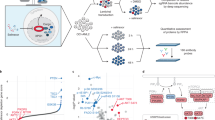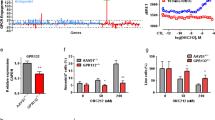Abstract
The anaplastic lymphoma kinase (ALK) is an oncogene product involved in hematopoietic and non-hematopoietic malignancies. Recent studies have demonstrated that nucleophosmin (NPM)-ALK, originated from the fusion of NPM and ALK genes, causes cell transformation through diverse mechanisms. Here, we show a novel mechanism by which NPM-ALK transforms lymphoid tumor cells to become resistant to glucocorticoid (GC) or dexamethasone (Dex) treatment. Transformed BaF3 cells by NPM-ALK were much more resistant to Dex compared with their parental cells, and concurrently had a constitutive activation of mammalian target of rapamycin (mTOR) signaling, as evidenced by hyperphosphorylation of its downstream effectors, p70 S6 kinase (p70S6K) and eukaryotic initiation factor 4E-binding protein 1 (4E-BP1). The mTOR inhibitor rapamycin suppressed activation of p70S6K in BaF3/NPM-ALK cells and reversed GC resistance by synergistically inhibiting mTOR signaling pathway, enhancing cell cycle arrest at G1 phase and promoting apoptotic cell death. In conclusion, our data indicate that the ALK fusion kinase, NPM-ALK, induces GC resistance by activating mTOR signaling, and addition of mTOR inhibitors to the chemotherapeutic regimen of ALK+ lymphomas may improve the prognosis.
This is a preview of subscription content, access via your institution
Access options
Subscribe to this journal
Receive 12 print issues and online access
$259.00 per year
only $21.58 per issue
Buy this article
- Purchase on Springer Link
- Instant access to full article PDF
Prices may be subject to local taxes which are calculated during checkout






Similar content being viewed by others
References
Greenstein S, Ghias K, Krett NL, Rosen ST . Mechanism of glucocorticoid-mediated apoptosis in hematological malignancies. Clin Cancer Res 2002; 8: 1681–1694.
Pui CH, Relling MV, Downing JR . Acute lymphoblastic leukemia. N Engl J Med 2004; 350: 1535–1548.
Gaynon PS, Carrel AL . Glucocorticosteroid therapy in childhood acute lymphoblastic leukemia. Adv Exp Med Biol 1999; 457: 596–605.
Kaspers GJ, Pieters R, Klumper E, De Waal FC, Veerman AJ . Glucocorticoid resistance in childhood leukemia. Leuk Lymphoma 1994; 13: 187–201.
Schrappe M, Reter A, Zimmermann M, Harbott J, Ludwig WD, Henze G et al. Long-term results of four consecutive trials in childhood ALL performed by the ALL-BFM study group from 1981–1995 Berlin-Frankfurt-Munster. Leukemia 2000; 14: 2205–2222.
Tissing WJE, Meijerink JPP, den Boer ML, Brinkhof B, van Rossum EFC, van Wering ER et al. Genetic variations in the glucocorticoid receptor gene are not related to glucocorticoid resistance in childhood acute lymphoblastic leukemia. Clin Cancer Res 2005; 11: 6050–6056.
Haarman EG, Kaspers GJ, Veerman AJ . Glucocorticoid resisitance in childhood leukemia: mechanisms and modulation. Br J Haematol 2003; 120: 919–929.
Schaaf MJM, Cidlowski JA . Molecular mechanisms of glucocorticoid action and resistance. J Steroid Biochem Mol Biol 2003; 83: 37–48.
Morris SW, Kirstein MN, Valentine MB, Dittmer KG, Shapiro DN, Saltman DL et al. Fusion of a kinase gene ALK, to a nuclear protein gene. NPM, in non-Hodgkin's lymphoma. Science 1994; 263: 1281–1284.
Morris SW, Naeve C, Mathew P, James PL, Kirstein MN, Cui XL et al. ALK, the chromosome 2 gene locus altered by t(2;5) in non-Hodgkin's lymphoma, encodes a novel neural receptor tyrosine kinase that is highly related to leukocyte tyrosine kinase (LTK). Oncogene 1997; 14: 2175–2188.
Pulford K, Morris SW, Turturro F . Anaplastic lymphoma kinase protein in growth control and cancer. J Cell Physiol 2004; 199: 330–358.
Gascoyne RD, Lamant L, Martin-Subero JI, Lestou VS, Harris NL, Müller-Hermelink HK et al. ALK-positive diffuse large B-cell lymphoma is associated with Clathrin-ALK rearrangements: report of 6 cases. Blood 2003; 102: 2568–2573.
Cessna MH, Zhou H, Sanger WG, Perkins SL, Tripp S, Pickering P et al. Expression of ALK1 and p80 in inflammatory myofibroblastic tumor and its mesenchymal mimics: a study of 135 cases. Mod Pathol 2002; 15: 931–938.
Jazii FR, Najafi Z, Malekzadeh R, Conrads TP, Ziaee AL, Abnet C et al. Identification of squamous cell carcinoma associated proteins by proteomics and loss of beta tropomyosin expression in esophageal cancer. World J Gastroenterol 2006; 12: 7104–7112.
Soda M, Choi YL, Enomoto M, Takada S, Yamashita Y, Ishikawa S et al. Identification of the transforming EML4-ALK fusion gene in non-small-cell lung cancer. Nature 2007; 448: 561–566.
Li R, Morris SW . Development of anaplastic lymphoma kinase (ALK) small-molecule inhibitors for cancer therapy. Med Res Rev 2008; 28: 372–412.
Ma Z, Cools J, Marynen P, Xiaoli C, Siebert R, Gesk S et al. Inv(2)(p23q35) in anaplastic large-cell lymphoma induces constitutive ALK tyrosine kinase activation by fusion to ATIC, an enzyme involved in purine nucleotide biosynthesis. Blood 2000; 95: 2144–2149.
Marzec M, Kasprzycka M, Liu X, El-Salem M, Halasa K, Rafhunath PN et al. Oncogenic tyrosine kinase NPM/ALK induces activation of the rapamycin-sensitive mTOR signaling pathway. Oncogene 2007; 26: 5606–5614.
Vega F, Medeiros LJ, Leventaki V, Atwell C, Cho-Vega JH, Tian L et al. Activation of mammalian target of rapamycin signaling pathway contributes to tumor cell survival in anaplastic lymphoma kinase-positive anaplastic large cell lymphoma. Cancer Res 2006; 66: 6589–6597.
Hay N, Sonenberg N . Upstream and downstream of mTOR. Genes Dev 2004; 18: 1926–1945.
Lopiccolo J, Blumenthal GM, Bernstein WB, Dennis PA . Targeting the PI3K/Akt/mTOR pathway: effective combinations and clinical considerations. Drug Resist updat 2008; 11: 32–50.
Wei G, Twomey D, Lamb J, Schilis K, Agarwal J, Stam RW et al. Gene expression-based chemical genomics identifies rapamycin as a modulator of MCL1 and glucocorticoid resistance. Cancer Cell 2006; 10: 331–342.
Li JF, Li GD, Gu L, Liu WP, Li FY, Liao DY et al. Activation of AKT/mTOR pathway in ALCL and its clinical significance. Chinese Journal of Hematology (in press).
Guertin DA, Sabatini DM . An expanding role for mTOR in cancer. Trends Mol Med 2005; 11: 353–361.
Albanell J, Dalmases A, Rovira A, Rojo F . mTOR signaling in human cancer. Clin Transl Oncol 2007; 9: 484–493.
Stromberg T, Dimberg A, Hammarberg A, Carlson K, Osterborg A, Nilsson K et al. Rapamycinsensitizes multiple myeloma cells to apoptosis induced by dexamethasone. Blood 2004; 103: 3138–3147.
Yan H, Frost P, Shi Y, Hoang B, Sharma S, Fisher M et al. Mechanism by which mammalian target of rapamycin inhibitors sensitize multiple myeloma cells to dexamethasone-induced apoptosis. Cancer Res 2006; 66: 2305–2313.
Irving JA, Minto L, Bailey S, Hall AG . Loss of heterozygosity and somatic mutations of the glucocorticoid receptor gene are rarely found at relapse in pediatric acute lymphoblastic leukemia but may occur in a subpopulation early in the disease course. Cancer Res 2005; 65: 9712–9718.
Thompson EB, Johnson BH . Regulation of a distinctive set of genes in glucocorticoid-evoked apoptosis in CEM human lymphoid cell. Recent Prog Horm Res 2003; 58: 175–197.
Holleman A, Cheok MH, den Boer ML, Yang W, Veerman AJ, Kazemier KM et al. Gene-expression patterns in drug-resistant acute lymphoblastic leukemia cells and response to treatment. N Engl J Med 2004; 351: 533–542.
Acknowledgements
We especially acknowledge Dr Steve Morris for providing Karpas299, BaF3 and NPM-ALK transformed BaF3 cell lines and helpful comment for this manuscript. We also thank Dr Shile Huang for stimulating discussions. This study was supported by Program for New Century Excellent Talents in University (NCET-05-0788).
Author information
Authors and Affiliations
Corresponding author
Rights and permissions
About this article
Cite this article
Gu, L., Gao, J., Li, Q. et al. Rapamycin reverses NPM-ALK-induced glucocorticoid resistance in lymphoid tumor cells by inhibiting mTOR signaling pathway, enhancing G1 cell cycle arrest and apoptosis. Leukemia 22, 2091–2096 (2008). https://doi.org/10.1038/leu.2008.204
Received:
Revised:
Accepted:
Published:
Issue Date:
DOI: https://doi.org/10.1038/leu.2008.204
Keywords
This article is cited by
-
Targeting mTOR/p70S6K/glycolysis signaling pathway restores glucocorticoid sensitivity to 4E-BP1 null Burkitt Lymphoma
BMC Cancer (2015)
-
Prognostic significance and therapeutic potential of the activation of anaplastic lymphoma kinase/protein kinase B/mammalian target of rapamycin signaling pathway in anaplastic large cell lymphoma
BMC Cancer (2013)
-
Rapamycin sensitizes T-ALL cells to dexamethasone-induced apoptosis
Journal of Experimental & Clinical Cancer Research (2010)



